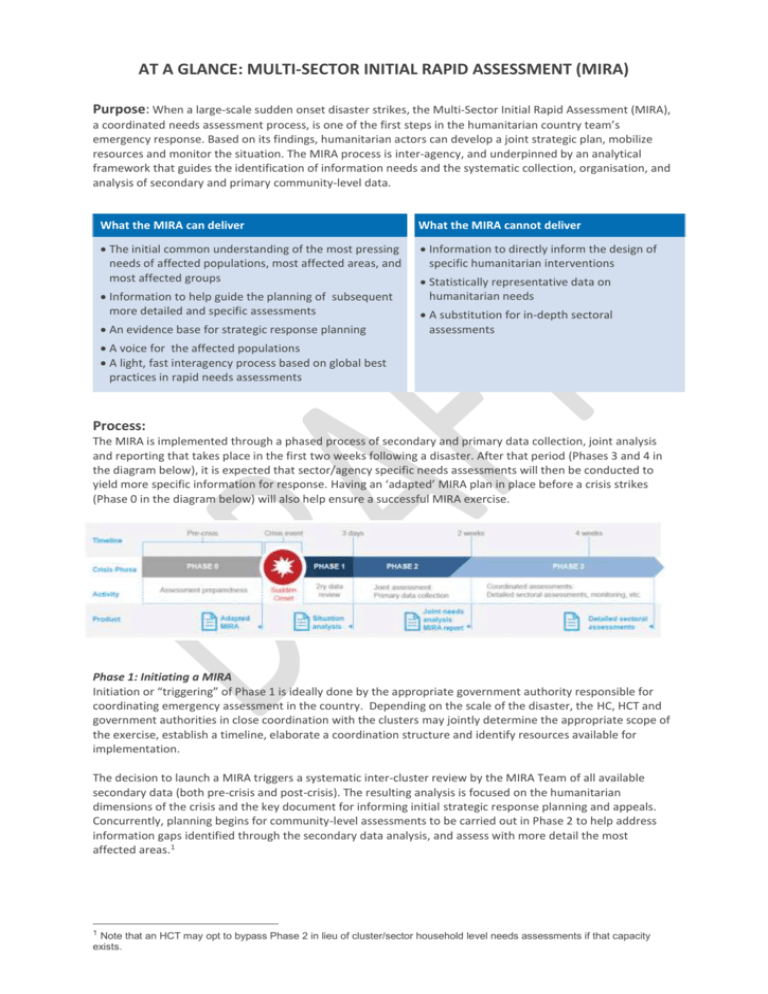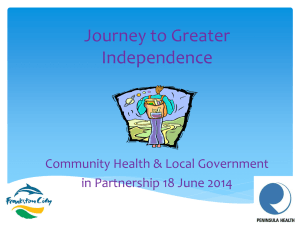IASC Draft MIRA 2
advertisement

AT A GLANCE: MULTI-SECTOR INITIAL RAPID ASSESSMENT (MIRA) Purpose: When a large-scale sudden onset disaster strikes, the Multi-Sector Initial Rapid Assessment (MIRA), a coordinated needs assessment process, is one of the first steps in the humanitarian country team’s emergency response. Based on its findings, humanitarian actors can develop a joint strategic plan, mobilize resources and monitor the situation. The MIRA process is inter-agency, and underpinned by an analytical framework that guides the identification of information needs and the systematic collection, organisation, and analysis of secondary and primary community-level data. What the MIRA can deliver What the MIRA cannot deliver The initial common understanding of the most pressing needs of affected populations, most affected areas, and most affected groups Information to directly inform the design of specific humanitarian interventions Information to help guide the planning of subsequent more detailed and specific assessments An evidence base for strategic response planning Statistically representative data on humanitarian needs A substitution for in-depth sectoral assessments A voice for the affected populations A light, fast interagency process based on global best practices in rapid needs assessments Process: The MIRA is implemented through a phased process of secondary and primary data collection, joint analysis and reporting that takes place in the first two weeks following a disaster. After that period (Phases 3 and 4 in the diagram below), it is expected that sector/agency specific needs assessments will then be conducted to yield more specific information for response. Having an ‘adapted’ MIRA plan in place before a crisis strikes (Phase 0 in the diagram below) will also help ensure a successful MIRA exercise. Phase 1: Initiating a MIRA Initiation or “triggering” of Phase 1 is ideally done by the appropriate government authority responsible for coordinating emergency assessment in the country. Depending on the scale of the disaster, the HC, HCT and government authorities in close coordination with the clusters may jointly determine the appropriate scope of the exercise, establish a timeline, elaborate a coordination structure and identify resources available for implementation. The decision to launch a MIRA triggers a systematic inter-cluster review by the MIRA Team of all available secondary data (both pre-crisis and post-crisis). The resulting analysis is focused on the humanitarian dimensions of the crisis and the key document for informing initial strategic response planning and appeals. Concurrently, planning begins for community-level assessments to be carried out in Phase 2 to help address information gaps identified through the secondary data analysis, and assess with more detail the most affected areas.1 1 Note that an HCT may opt to bypass Phase 2 in lieu of cluster/sector household level needs assessments if that capacity exists. Phase 2: Primary data collection and Reporting On the basis of information needs identified during the review of secondary data, a community-level assessment is carried out to collect primary data through location visits and interviews2. The MIRA team brings together secondary and primary data in a joint analysis process to generate a MIRA Report that will inform the next cycle of response analysis and strategic planning.3 Roles & Responsibilities HCT Initiate conversation and decide in-country if MIRA is the most appropriate tool for the context. Determine the broad parameters of the MIRA. Identify the analysis team responsible for the MIRA4 . Critically review the findings of the MIRA report. Use the MIRA findings as the basis for determining initial and strategic response priorities. Approve the MIRA findings ICCG Cluster members/partners MIRA Team Government Review MIRA report findings prior to HCT review Utilise findings from the MIRA for: Strategic decision-making Harmonising geographically and sectorally cluster/sector detailed needs assessments. Highlight initial findings from field assessment teams. Raise concerns potential hazards, known and anticipated vulnerabilities in cluster meetings. Provide feedback on geographic priority areas based on need rather than access. Indicate cultural norms to be considered when conducting the MIRA. Provide resources and staff members to the MIRA Determine data collection methodologies and synthesis technique, in consultation with the clusters. Plan and coordinate the MIRA. Analyse the MIRA findings and Draft and present report to ICCG. Once reviewed by ICCG present to HCT. Provide leadership and technical support. Review the findings of the MIRA report. Structure: The MIRA report is structured into six sections: 1. Priority needs: summarizes the three to five most pressing humanitarian problems at as holistic and intersectoral levels as appropriate. This section flags priority humanitarian needs, most affected regions, and most affected groups 2. Impact of the crisis: describes the situation by analyzing drivers, underlying factors, geographic scope, demographic profile and the situation of affected populations, while fully integrating a protection and gender analysis. 3. Response capacities: includes the capacity of the HCT to deliver. In the Strategic Response Plan (SRP) this is expanded to include an initial analysis of response capacity of humanitarian actors within and outside of the HCT inclusive of national government, affected populations and other organizations. Note that this will be addressed in more depth in the SRP.5 4. Humanitarian access: constraints could be physical, political or bureaucratic. Security constraints include the safety and conditions for implementing humanitarian assistance. Special considerations may apply in case a peacekeeping or political mission is deployed in the country. 5. Most likely scenario: How humanitarian impacts, needs, response capacities and access are likely to evolve in the near and mid – term. 6. Information gaps: highlights information gaps that will continue to impact response operations and require further assessments unless additional, more detailed assessments are carried out 2 MIRA Sampling techniques typically focus on the community or community group level; sample sizes are generally small and focused and not intended to be statistically representative 3 Reference the SRP guidance 4 Comprised of cluster representatives, representatives from the affected population, needs assessment technical experts from clusters, NGO and government 5 Link to guidance








